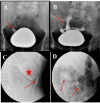Pseudo-acute kidney injury after minor trauma: A case report and review of literature
- PMID: 34693398
- PMCID: PMC8514145
- DOI: 10.1002/emp2.12564
Pseudo-acute kidney injury after minor trauma: A case report and review of literature
Abstract
Acute kidney injury (AKI), a common diagnosis in the emergency department, is defined as a reduction in renal filtration function, with decrease in urine output, increase in serum creatinine, or both. However, a rise in serum creatinine can occur without AKI: the principal cause of a pseudo-AKI is urinary ascites, caused by urinary tract rupture, followed by reverse intraperitoneal dialysis and resorption of creatinine. The intraperitoneal leak of free urine is mainly traumatic, and half of the cases are iatrogenic. A case of intraperitoneal bladder rupture after minor trauma is presented with a review of the pathology of pseudo-AKI.
Keywords: acute kidney injury; bladder injury; emergency department; pseudo‐acute kidney injury; reverse autodialysis; urinary ascites.
© 2021 The Authors. JACEP Open published by Wiley Periodicals LLC on behalf of American College of Emergency Physicians.
Conflict of interest statement
The authors declare no conflict of interest.
Figures

References
-
- Mirza R, Wong EK, Yang R, Clase C. Abdominal pain, hyperkalemia, and elevated creatinine after blunt trauma: bladder rupture and pseudo–acute‐kidney‐injury. Can J Gen Intern Med. 2018;13(2).
-
- Simon LV, Sajjad H, Lopez RA, Burns B. Bladder rupture. 2021 Jul 28. In: StatPearls [Internet]. Treasure Island (FL): StatPearls Publishing; 2021 Jan. PMID: 29262195. - PubMed
Publication types
LinkOut - more resources
Full Text Sources
